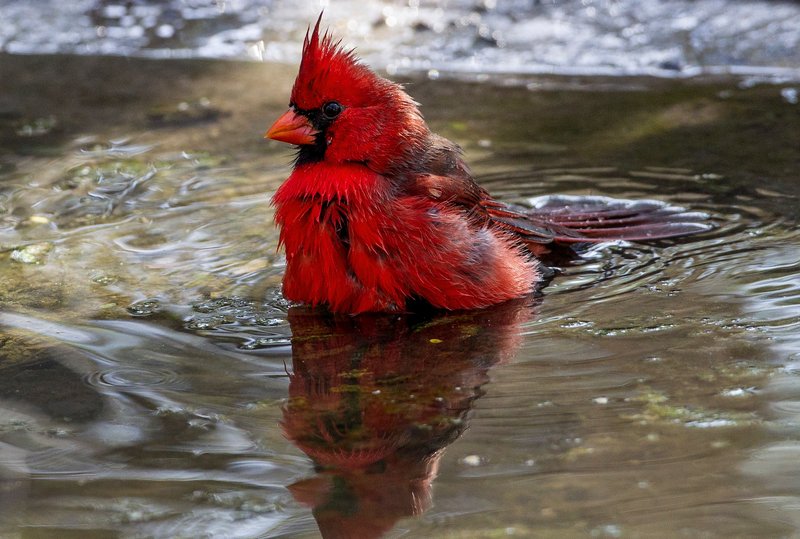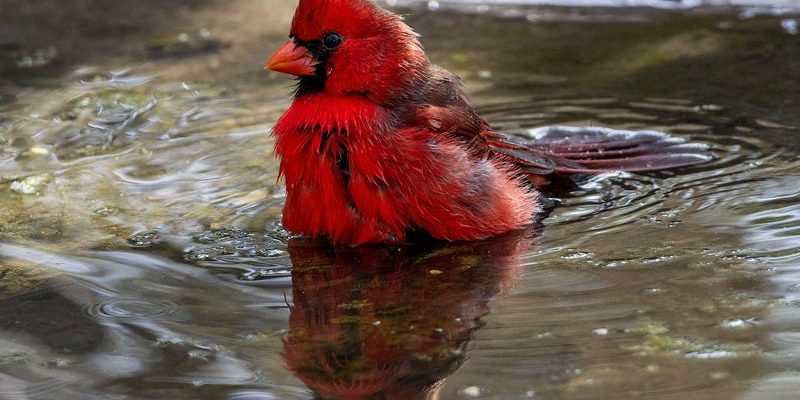
Cardinals are like nature’s charming little jewels, often brightening our backyards with their stunning colors and melodious songs. When you see a cardinal, it’s hard not to be captivated by its vivid red plumage and striking black mask. These birds aren’t just pretty faces; they have fascinating behaviors and rich cultural significance too. Whether you’re an avid birdwatcher or just someone curious about the wildlife around you, learning about cardinals can be a delightful experience.
Often associated with joy and happiness, the cardinal is not just a seasonal visitor. You can enjoy their presence year-round, especially in North America. They have a friendly nature and often become familiar with their surroundings, which allows us to observe them up close. So, let’s dive into the world of cardinals and uncover what makes them so special!
Physical Characteristics
Cardinals are best known for their striking appearance. Males are dressed in bright red feathers that make them stand out against the green backdrop of trees and bushes. These bold colors serve not only to attract mates but also to establish territory. In contrast, female cardinals wear more muted shades of brown with hints of red, allowing them to blend into their environment—an essential trait for avoiding predators.
Beyond color, cardinals have a robust body and a distinctive crest on their heads, which can be raised or lowered depending on their mood. Their short, thick bills are perfect for cracking seeds, which are a significant part of their diet. Interestingly, cardinals also have a unique vocal ability. They produce a variety of songs and calls that not only communicate their intentions but also help in identifying each other.
Here’s a quick table summarizing some essential facts about cardinals:
| Size: | 8.3–9.1 inches long |
| Weight: | 1.5–1.7 ounces |
| Wingspan: | 9.8–12.2 inches |
| Lifespan: | 3–15 years in the wild |
| Habitat: | Woodlands, gardens, and shrublands |
Behavior and Social Structure
Cardinals are incredibly social birds. They often travel in pairs or small family groups, which makes them a common sight in backyards. You might be wondering how they interact with each other. Well, these birds are known for establishing strong bonds; mated pairs usually stay together for life. This loyalty is heartwarming to witness, especially during courtship rituals where they will feed each other seeds—a beautiful sign of affection.
When it comes to their territory, male cardinals can be quite territorial. They will sing loudly to announce their presence and ward off any intruders. Their songs are not just pretty melodies; they serve as a way to communicate and establish dominance in their space. If another male challenges them, you might see some impressive displays of strength, including aerial acrobatics!
Interestingly, cardinals also have some unique behaviors during the winter. When temperatures drop, they may flock together with other birds to stay warm. This social behavior helps not only with warmth but also with foraging—more eyes mean more chances to find food. Have you ever seen a group of cardinals feasting on seeds together? It’s quite a sight!
Diet and Feeding Habits
When it comes to food, cardinals are primarily seed eaters. Their strong bills make short work of nuts and seeds, particularly sunflower seeds. They are often seen foraging on the ground, scratching the leaf litter to uncover tasty treats. However, their diet is not only limited to seeds. Cardinals also enjoy fruits, grains, and even insects during the breeding season, providing essential protein for their growing chicks.
You might find cardinals at bird feeders in your yard, especially if you offer a mix of seeds and nuts. Sunflower seeds and pebbles are particular favorites. If you want to attract them, consider adding a feeder with a roof to keep the seeds dry, and place it near bushes or trees where they feel safe. Remember, placement is key—cardinals prefer to dine in spots where they can quickly flee if a predator appears.
It’s fascinating to see how adaptable cardinals are. In urban areas, they have learned to thrive alongside humans, often venturing into parks and gardens. They’ve become a symbol of resilience, constantly finding ways to adjust their feeding habits according to what’s available in their environment.
Cardinal Breeding and Nesting
Cardinals typically breed in spring, with courtship beginning as early as February in warmer climates. Males become quite devoted during this time, performing elaborate displays to attract potential mates. They will sing, fluff their feathers, and even bring food to the female as part of their courtship ritual. Once they form a pair, they will often mate for life, returning to the same nesting sites year after year.
Nesting takes place in dense shrubs or small trees, providing a sheltered spot for their young. The female primarily builds the nest using twigs, grasses, and leaves, laying about 2 to 5 eggs at a time. The eggs are typically light blue with speckles, making them blend perfectly with their surroundings. This camouflage is crucial, helping to protect the eggs and later the chicks from hungry predators.
Both parents take turns incubating the eggs, usually for about 11 to 13 days. Once hatched, the chicks are helpless and depend entirely on their parents for food. It’s a busy time for the cardinals, as both parents work tirelessly to find food and protect their young from threats. In just a few weeks, the chicks will fledge and leave the nest, continuing the cycle of life for these beautiful birds.
Cardinals in Culture and Symbolism
Throughout history, cardinals have held various meanings in different cultures. In many traditions, they are seen as symbols of hope, love, and spiritual connection. Many people believe that when a cardinal appears, it’s a sign from a loved one who has passed away, offering comfort and reassurance. This belief makes sightings of cardinals particularly special, filled with significance and emotion.
Artistically, cardinals have inspired countless works, appearing in paintings, literature, and even holiday decorations. Their vibrant red color contrasts beautifully with winter landscapes, making them a seasonal favorite. In fact, many people hang images or decorations of cardinals during the holidays, symbolizing warmth and cheer during the cold months.
In North America, the cardinal is also the state bird for several states, including Illinois and West Virginia. Their presence is cherished, and their songs are often associated with the arrival of spring. As you can see, this little bird carries a lot of weight in the hearts and cultures of many people, serving as a reminder of nature’s beauty and the connections we share with those we love.
Conservation Status
Fortunately, cardinals are generally not considered at risk, and their populations remain stable across much of their range. However, habitat loss due to urbanization and agricultural development continues to pose a threat. The good news is that cardinals are quite adaptable and can thrive in residential areas, so creating bird-friendly environments can help ensure their long-term survival.
One effective way to support cardinals is by planting native shrubs and trees. These plants provide essential food and nesting sites while creating a welcoming habitat. You might also consider setting up bird baths to offer fresh water, especially in summer when natural sources can dry up. By making small changes in your backyard, you can play a significant role in supporting these beautiful birds.
Community awareness and involvement in conservation efforts can also help keep cardinals thriving. Many organizations work to educate the public about the importance of protecting natural habitats and promoting biodiversity. By staying informed and participating in local initiatives, we can all contribute to the health of ecosystems that support our feathered friends.
FAQ
What do cardinals eat besides seeds?
Along with seeds, cardinals enjoy a varied diet that includes fruits like berries and insects during the breeding season. This mix helps provide the necessary nutrients, particularly for the chicks. They often forage on the ground or in bushes to find these food sources, showing their adaptability in different environments.
How can I attract cardinals to my backyard?
Attracting cardinals can be as simple as setting up bird feeders stocked with sunflower seeds and placing them near shrubs or trees. Adding a bird bath can also help, providing a fresh water source for them. Creating a bird-friendly habitat with native plants will encourage cardinals to visit regularly.
Are cardinals solitary or social birds?
Cardinals are quite social. They typically travel in pairs or small family groups, especially after the breeding season. Males are known to be territorial but often share their space with their mate and their young. Watching them interact can be a delightful experience!
How long do cardinals live?
The lifespan of a cardinal can vary widely, usually ranging from 3 to 15 years in the wild. Factors like environmental conditions, predation, and availability of food can influence their longevity. Observing them in your backyard can give you a glimpse into their fascinating lives.
Do cardinals migrate?
Most cardinals do not migrate; they are year-round residents in their habitats. However, those living in the northernmost parts may move slightly south during particularly harsh winters. Overall, they prefer to stay in familiar environments where they can easily find food and shelter.
What is the significance of the cardinal in different cultures?
Cardinals hold various meanings across cultures. Many people view them as symbols of hope and spiritual connections, often believing that they are messages from loved ones who have passed. Their striking appearance and songs also lend them a special place in art and folklore, making them beloved symbols in many traditions.
Are female cardinals as colorful as males?
No, female cardinals exhibit more muted shades of brown with hints of red. This coloring allows them to camouflage better in their surroundings, which is vital for protecting their nests and young from predators. Despite their less vibrant appearance, females are equally captivating!
Can cardinals be kept as pets?
Keeping cardinals as pets is generally not advisable. They are wild birds that thrive in nature, and keeping them in captivity can lead to stress and health issues. Instead, it’s best to enjoy their beauty and behavior in their natural habitats, where they can flourish and contribute to the ecosystem.
What are the most common cardinal species?
The Northern Cardinal is the most recognized species, especially in North America. Other species like the Pyrrhuloxia and the Desert Cardinal can be found in specific regions, but the Northern Cardinal remains the most popular and widespread among birdwatchers.
How do cardinals communicate?
Cardinals use a variety of songs and calls to communicate. Their melodies can express different messages, from mating calls to territorial warnings. Each bird has a unique song, making it easier for mates and family members to identify one another.
What can I do to help protect cardinals?
You can help protect cardinals by creating bird-friendly environments. Planting native shrubs, providing clean water sources, and minimizing pesticide use in your garden can all make a significant difference. Participating in local conservation efforts can also contribute to maintaining healthy ecosystems for these beautiful birds.
What are some interesting facts about cardinals?
Cardinals are fascinating creatures! One interesting fact is that they have strong, distinctive personalities and can be quite curious. They often approach humans while foraging and can be very social, especially during the non-breeding season. Their unique songs serve not only to attract mates but also to establish territories and communicate with their family members.

